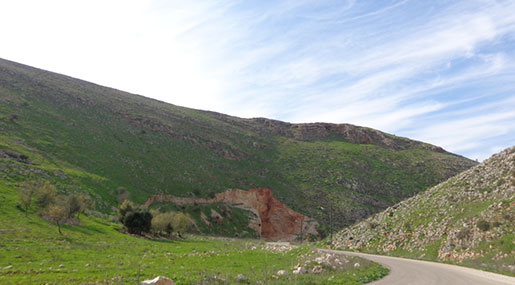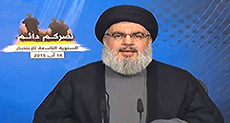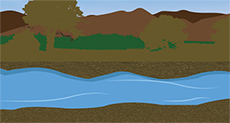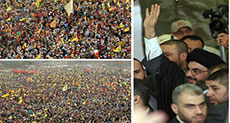Hojeir Valley...Memories and Epics

Charles Abi Nader
What might most express the fatal shock that struck the "Israeli" enemy soldiers during their humiliating defeat in the war of July 2006, is expressed by one soldier who described his feelings as he approached death itself.
Death came in the form of fireballs, which he anticipated [to strike him] as he sat in a Merkava Tank on one of the hills that stretched from Hojeir Valley toward the town of Ghandouriyeh, at a time when he saw the rest of his unit's tanks burning left, right, and center. He could hear the screaming and howling of the crew members of the most sophisticated and powerful armored vehicle in the world.

In an attempt to remember the event, I am unsure whether I first heard about Hojeir Valley or al-Salouki in the media, in relation to the operations of the resistance against the enemy before 1984 - the year that I volunteered to join the army as a student officer - or whether I had come to know of this valley from the military maps during my studies at war school. However, what I do know for sure is that its name had been imprinted in my memory at the time with a strange feeling that always remained with me until I saw it for myself directly after the [Lebanese] army was deployed along the entire border with the Israeli enemy in order to carry out Resolution 1701.
What I found at the time was a valley that geographically spread over a distance that is by no means small, relative to the size of the valleys in the south in general. The valley linked most of the towns that experienced the Israeli occupation before liberation in the year 2000, or those towns that were the site of the fiercest battles between the resistance and the enemy during the July War, until the issuance of the resolution in mid-August 2006.
This point in time also witnessed the beginning of my task as a commanding officer for a particular sector within the valley, and to satisfy my curiosity regarding this strange mystery about this sensitive area from my perspective. I worked hard and within a short period of time, to form a complete understanding, as much as possible, of the military, operational, and tactical importance of this valley. This was done with the aim of benefitting from this value first and foremost, and in addition, to organize and prepare the ground for the holy confrontation in defense of the border, by taking advantage of suitable land mass in the valley and the surrounding hills for the purpose of maneuvering.
From the routes that lead into the valley from the aforementioned towns, and during an initial look at the valley before entering it, the view from a military and operational perspective differed from one town to another. From the point overlooking the valley from between the towns of ‘Majdal Silim' and ‘Shakra' for example, it apparently seemed like it was the eastern entrance to the valley that acted as a linking point for more than one frontier or crossing, which the enemy - whether on foot or in armored vechiles - could use to either enter or withdraw.
Consequently, it was the ideal area for carrying out ambushes on ["Israeli"] patrols in this area, and this is what use to happen in general before the liberation in the year 2000, or what the resistance use to prepare for during the aggression in July 2006.
From the hills belonging to the towns of ‘Qabrikha' and ‘Tuleen' for example, that overlook the valley, it appeared that the latter was the ideal location for situating launch pads for short and medium-range missiles, tunnels, and bunkers aimed at protecting these weapons, their personnel, and equipment. It turned out that the area of the valley in the north situated below these two towns directly was most active for launching of missiles, which continued to strike nearby regions of enemy territory during the 33 days of the July War.
From the hills overlooking the valley to the west from the towns of ‘Ghandouriyeh' and ‘Furoon', it seemed that the valley - which was considered to be just about the only point suitable for the advance of enemy armored units - was the ideal spot from which to monitor, target, and destroy these armored vehicles from maximum-distance ranges effective for the firing of anti-armor ‘Kornet' missiles. And this is what happened, whereby the "Massacre of the Merkava" occurred, which was talked about much, and which will not be forgotten by the civilian and military history of the enemy.
After you enter the valley and move along its passable tracks, or near other roads that have naturally become impassable, or for otherreasons that make the ground appear like blood vessels, you will feel the greatness of this sacred valley, and take in the scent of heroism and dignity when you pass near the many monuments of the resistance fighters who were martyred in the confrontations with the enemy at these sites or in their proximity.
It will allow your military imagination to conjure up images of battles and confrontations that deserve to be studied in military schools, and to be models for the training of special units resisting occupying armies.
Finally, what is striking in my experience with this land, which surrounds this valley and its surrounding area, and which has etched in my memory images, scenes, and numerous epics, is an incident which I will never forget. One of the sons of this land told me, after I saw a part of a turret for a Merkava tank, which he proudly displayed in front of his home, that he is prepared to sacrifice his blood for the resistance and Sayyed Hassan [Hizbullah Secretary General].
However, he will not accept, and over his dead body, that anyone confiscates this turret from him, because he considers it the only link that connects him with his martyred father, who fell as a martyr as a result of a shell fired from a Merkava Tank during confrontations with the enemy at a site that overlooks Hojeir Valley.
Source: Al-Ahed News, Translated and Edited by webiste team



